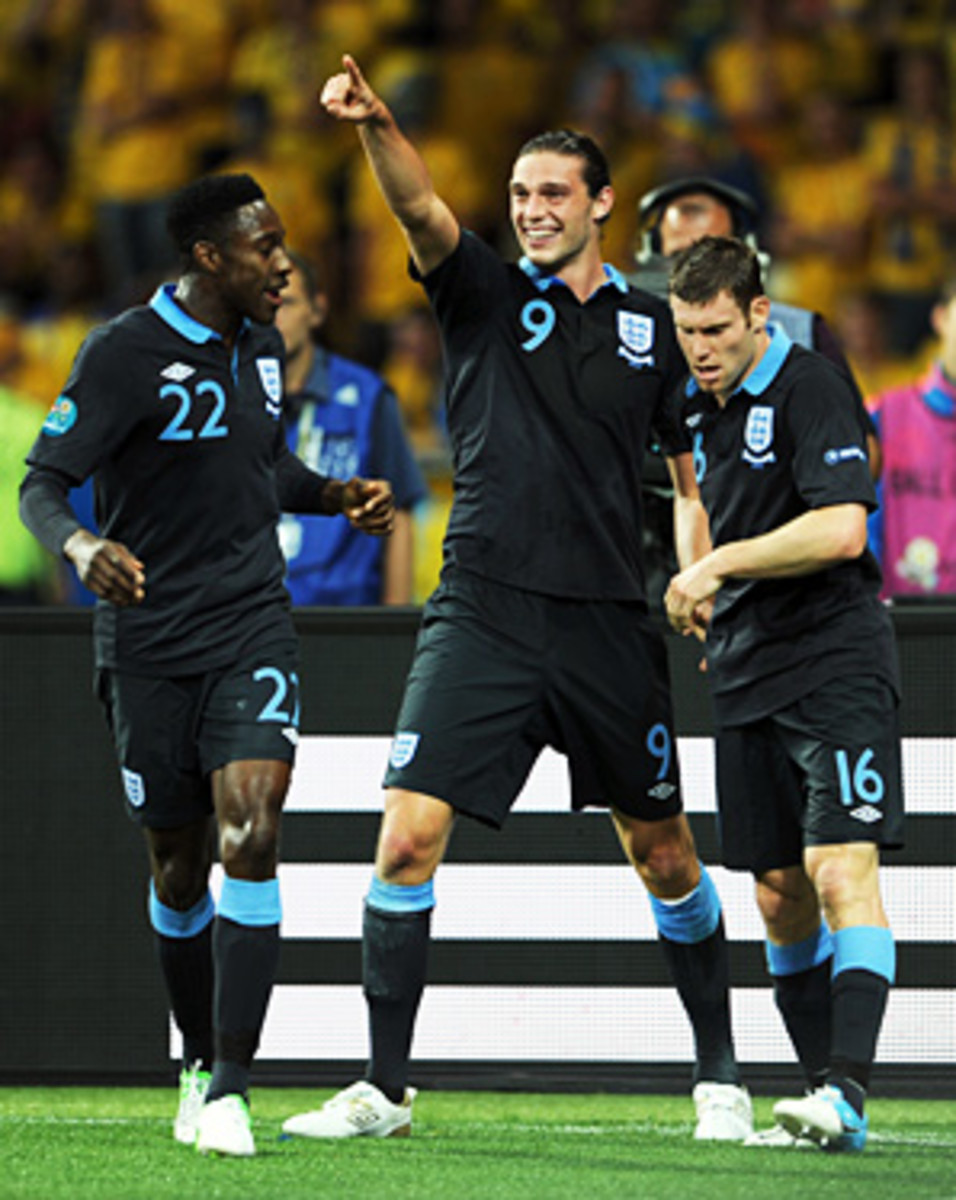
Three thoughts: England switch to 4-4-2 keys comeback over Sweden
Three thoughts from England's dramatic 3-2 victory over Sweden in Kiev, Ukraine.
1. England is winning with 4-4-2. There is a scene in Steve Barron's 2001 film Mike Bassett: England Manager, an affectionate satire on the England national team, in which Ricky Tomlinson, playing the title character, reaches the end of his tether. He reacts furiously to the suggestion that he might experiment tactically. "Four-four-fookin'-two," he shouts as the audience laughs at a poor, befuddled man out of his depth. Eleven years later, England is again playing 4-4-2. And somehow, it seems to be working.
The truth is, unsophisticated and old-fashioned as it may seem, 4-4-2 is comforting and familiar for English players -- tactical chicken soup in a time of crisis. Roy Hodgson brought in Andy Carroll for Alex-Oxlade Chamberlain and subsequently moved Ashley Young from a position behind the front man to the left. He changed the shape from 4-4-1-1 to orthodox 4-4-2. Hodgson said before the game that he wanted to match Sweden's aerial ability, but that might have been a diplomatic way of saying he noted that Sweden had conceded seven goals so far in 2012: six headers and an own goal.
Six soon became seven. Steven Gerrard's cross from the right was superb, and Carroll's finish was sensational. Carroll brushed by his marker, Andreas Grandqvist, and hammered his header past Andreas Isaksson. As early as the 1950s, writers such as Brian Glanville were bemoaning the English reliance on the "brainless bull at the gate" style of center forward, but there remains something viscerally thrilling about a proper muscular header. As the ball boomed off Carroll's forehead, he hung in the air for a moment, his neck muscles thrusting, his body shape out of a textbook. Only his flapping ponytail indicated that he wasn't Tommy Lawton or Nat Lofthouse bullying in a delivery from Tom Finney or Stanley Matthews.
A museum piece, but no less valuable for it, and Carroll wouldn't have even been on the squad, especially if Fabio Capello were still manager. Traditional logic argues that the two banks of four make for boring, containing football. And in theory, it should. But the fact that the match was so thrilling is a credit to Hodgson, and to his personnel moves bringing in Carroll and introducing Theo Walcott from the bench.
In a sense, that's not even the most important thing: A point from its final game will be enough to take England through to the quarterfinals. After nearly a decade of insipid performances at major tournaments, England was involved in a thrilling game -- the best in terms of incident and drama since the 2-2 draw and penalty shootout loss to Portugal in the Euro 2004 quarterfinal.
2. England's neuroses remain very close to the surface. No side completed fewer passes in its first game than Sweden and -- while it was better against England -- it was still astonishingly wasteful with possession in the first half. England snapped and snarled and was sharp in the tackle, but it didn't play nearly as well as Sweden made it seem. With Johan Elmander clearly not fully fit, Sweden really struggled, and only the very occasional flash from Zlatan Ibrahimovic offered any sort of threat. At halftime, England led 1-0 and was markedly comfortable.
Yet three or four minutes of Swedish pressure at the start of the second half were enough to induce English panic. When the equalizer came, it was gifted to Erik Hamren's side by a combination of good luck and bad defending -- and Ibrahimovic. His wildly optimistic bicycle kick was heading wide when it deflected to Olof Mellberg, played onside by the dozy Glen Johnson. Joe Hart saved his shot splendidly, but the ball hit Johnson and spun over the line despite Hart's frantic attempts to clear. Even the free kick that led to the goal was the result of a stupid, needless tackle from Carroll.
From then on, England played in a mist. Hodgson may be the king of shape, but for the 20 minutes that ensued, England became unraveled. Somehow, the mess produced goals at both ends. First Mellberg was appallingly undefended as he headed in Seb Larsson's free kick. Then, Theo Walcott -- on as a substitute -- thrashed an equalizer. The game was stretched to breaking point, with both sides thrillingly losing their heads.
3. Goalkeeping is a thankless job. After 63 minutes, Andreas Isaksson, the Sweden goalkeeper, made a sensational save. Johnson's cross was good, John Terry got behind his marker and headed the ball down from close range and somehow the Sweden keeper -- the tallest man in the competition -- dropped to make a reflexive parry, diverting the ball into the ground and over the bar.
Less than a minute later, Theo Walcott, who hadn't scored an international goal since his hat trick in Zagreb in 2008, struck a straight shot down the middle of the goal. Perhaps inexplicably, Isaksson took a step to his left before realizing that the ball was going directly into the space he just vacated. The brilliant save was forgotten and England suddenly was back into the game. Danny Welbeck's exquisitely conceived and executed back-heel volley -- from a terrific Walcott cross -- completed an improbable England comeback.





